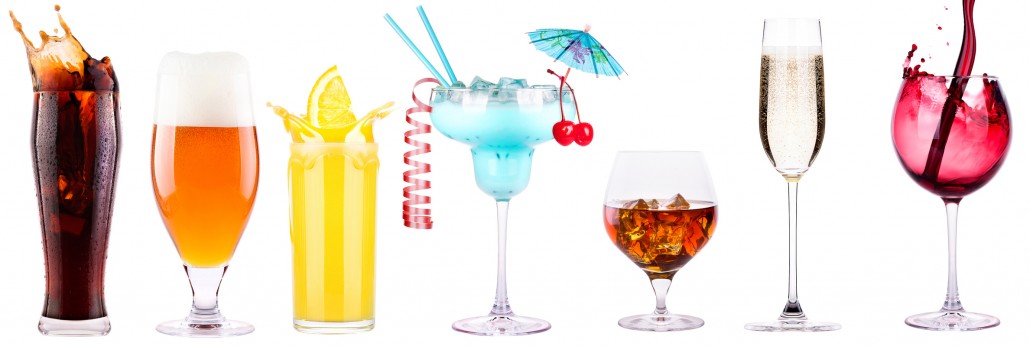Alcohol use has become a well-established part of our culture. In fact, its use as a social facilitator for family functions, business get-togethers and holiday extravaganzas has become nearly as acceptable as food. And although alcohol does play a vital role in many of society’s traditions and practices, its mass level consumption needs to be explored at a deeper level to see its real impact on our health and weight loss efforts.
Although an occasional drink can have a perfectly acceptable place in a healthy lifestyle, exceeding one drink per/day may inadvertently sabotage weight loss efforts and increase health risks.
One major effect that alcohol has, which is rarely ever discussed, is its over-all impact on our body composition (the over-all percentages of fat, bone, water and muscle in our body). Unlike macronutrients (such as; protein, carbohydrates and fat), alcohol – as it stands – is purely an empty calorie commodity, meaning it provides NO nutritional value.
Alcohol, being 7 calories per/gram, is quite calorie dense. In fact, it contains nearly twice as many calories (per/gram) than both protein or carbohydrates, and just slightly less than fat. But even more important than its high calorie content is the effect alcohol has on your weight and health as a result of how it’s metabolized.
Alcohol is metabolized differently than other foods and beverages. Under normal conditions, your body gets its energy from the calories consumed in proteins, carbohydrates and fats (our macronutrients). Alcohol, however, does not fall into any of these macronutrient categories. Therefore, when alcohol is consumed, it receives immediate attention from the body, because it is viewed by the body as a toxin.
When the body is focused on processing alcohol, it is unable to properly digest foods containing proteins, carbohydrates and fats. Therefore, the otherwise useful calories are carried away and converted into body fat to be stored on your body for future energy.
Alcohol is the first fuel to be used when combined with carbohydrates, fats and proteins, thus, postponing the fat-burning process and contributing to greater fat storage
Again, as already explained but worth repeating, alcohol supplies almost twice as many calories as protein and carbohydrates. In fact, alcohol has only two fewer calories per/gram than fat, which is 9 calories per/gram. It must also be remembered that the calories in alcohol lack any nutrients that are beneficial for a healthy metabolism, and therefore, hastens fat storage.
The calories found in the average alcoholic drink are quite concentrated compared to nearly all of the foods we consume causing us to inadvertently take in many more calories than would otherwise be consumed. To amplify this alcohol is quite deceptive in that it passes through our system rapidly, often before we are even aware of the number of drinks we consume.
Alcoholic drinks can also contain even more calories from other insidious sources, like soda, which adds to its overall, nutrient deficient, calories. Many cocktails, for instance, contain a very high carbohydrate content which has an immediate reaction with the release of insulin, resulting in rapid fat storage.
Let’s take a look at 5 ways alcohol can sabotage your weight loss efforts while impacting your health.
1. Alcohol is Metabolized Differently
When alcohol is consumed, it receives immediate attention from the body because it is viewed as a toxin. When the body is focused on processing alcohol, it is unable to properly digest proteins, carbohydrates and fats. Therefore, these otherwise useful calories are carried away and converted into body fat to be stored for future energy.
2. Alcohol Induces Thirst
Bars often serve salty foods, such as peanuts, chips and pretzels, together with alcoholic drinks. This is because salt and alcohol induce thirst, making you want to drink more. However, calories from the snacks and the alcoholic drinks only accumulate and will lead to excess weight gain.
3. Alcohol Causes Dehydration
Alcohol is a diuretic, meaning it causes water loss and dehydration. Along with this water loss the body loses important minerals, such as magnesium, potassium, calcium and zinc. These minerals are vital to energy and focus, the maintenance of fluid balance, bodily chemical reactions, and muscle contraction and relaxation. Further, dehydration can cause muscle cramping, twitching, gastrointestinal discomfort, and the all too dreaded headaches associated with overindulgence.
4. Alcohol Induces Hunger
Skipping a meal or meals in anticipation of the extra calories from alcohol is a bad idea. An empty stomach will only compound the effects of alcohol and make you eat more as your inhibitions are reduced and impulsivity increases. In this state, you are more likely to choose greasy or fried foods that will add to your waistline.
5. Alcohol Loosens Inhibition
Because alcohol contains only empty calories, it does not give you the feeling of fullness that healthier beverages provide. In addition, because it affects the brain, alcohol loosens your inhibitions and reduces your willpower to resist eating more. This effect of alcohol makes it an excellent aperitif. The more you drink, the hungrier you get, and the greater the tendency to overeat.
Bottom Line:
Alcohol can easily be the enemy when it comes to weight loss. It adds extra calories to your diet, alters normal metabolic and digestive processes, and encourages you to eat more food. Not only are the extra calories a hindrance, but the changes in how foods are processed will turn those extra calories into unwanted body fat.
5 simple suggestions on how to moderate alcohol when trying to Lose Weight
Like any habit that can impact your weight, consistency is always the true key to getting —and keeping— results. So if you’re reluctant to take a complete abstinence from alcohol, use these 5 simple suggestions outlined below to create some sort of workable balance.
1. Know your healthy moderation level
Research shows that both men and women who drink in moderation are less likely than non-drinkers to be obese due to its apparent protective effect against coronary heart disease (CHD), which happens to be the number one cause of death in the U.S. On the flip side however, more than moderate drinking is linked to a greater risk of being overweight or obese.
So what’s moderation?
- For a woman, it’s one “standard drink” per day
- For a man, it’s two “standard drinks” per day.
One standard drink is either a 1.5 ounce shot of 80 proof distilled spirits, 5 ounces of wine or 12 ounces of beer. Each of these contains about the same amount of alcohol, and will therefore raise your blood alcohol concentration fairly equally.
And please keep in mind that you cannot roll your alcoholic beverages over, so abstaining during the week and downing 7 to 14 drinks over the weekend doesn’t count as healthy or moderate drinking.
Suggestion: On a given day, 36 percent of men and 21 percent of women consume alcohol, and most don’t exceed the recommended limits. If you’re not sure if you’re overdoing it, track your intake for a week or two. I’ve personally had clients say they think they’re light drinkers, only to find out that they’re well above what’s considered moderate after logging their consumption.
2. Be portion conscious
One recent study found that the average amount of wine and liquor served at restaurants was about 40 percent more than a standard drink. Also, ordering a pint of beer rather than a bottle means an extra 4 ounces. Then there are the infamous smoothie style mixed drinks, like a frozen margarita in a mug, which can pack nearly 600 empty calories on. That’s as much, or more, than many entire meals would provide.
Suggestion: When you’re out, watch the bartender make or pour your drink, try to eyeball the amount, and adjust your estimation accordingly. In other words, the one drink you paid for may actually contain one and a half, or two portions. At home, grab a jigger to measure liquor, and use smaller wine and cocktail ware – liquid served in a smaller, fuller glass really does feel like more than the same amount served in a larger, emptier one.
3. Be carb smart
Vodka sodas have become the customary skinny cocktail because both vodka and club soda (not tonic – which is usually infused with corn syrup) are carb-free. Twelve ounces of ultra-low-carb beer, or 5 ounces of dry wine contain a little more (about 3 to 4 grams respectively), but a regular beer packs at least 10 grams, which is about as much as a quarter cup of brown rice. Just 4 ounces of cola contains about 12 grams, and the same amount of sour mix will cost you a whopping 25 grams of carbs.
Suggestion: If you’re drinking with a meal or appetizer that contains high carbs, scaling back your drink is a really good idea. One regular beer three nights a week snowballs into over 1,500 surplus carb grams a year. To put that in better perspective that’s as much as 100 slices of bread.
4. Mind your mixers
A 100-calorie shot of tequila turns into a 500-calorie margarita once it’s swirled into a sugary mixer. But you can whip up healthier, slimmed down versions of slushy umbrella drink cocktails. Eight ounces of Pina colada mixer contains 250 calories. For a third of the calories and a lot more nutrients, blend a handful of ice with one-quarter cup each 100 percent pineapple juice, coconut milk (the kind in the dairy case) and sliced banana.
Suggestion: Use watered down, frozen, unsweetened fruit to create a cocktail base, spruced up with antioxidant rich add-ins like fresh grated ginger. One of my favorite combos is strawberries with sprigs of fresh mint. Or if on the rocks is more up your alley, look for recipes using grapefruit, green tea or basil.
5. Alcohol influences unhealthy snacking
Alcohol can act as an appetite stimulant and lower inhibitions which is a double whammy recipe for an over-indulgence disaster. Let’s admit that we’ve all gobbled down foods while “under the influence” that we would most likely never touch when stone sober. So, in addition to everything else outlined here, this is a key reason that most weight loss plans nix alcohol.
Suggestion: To prevent post-drinking noshing you’ll regret the next day, prep some healthy options before you go out. If they’re ready to eat and right in front of you when you get home, you’ll be less likely to reach for chips or cookies. Good options include pre-popped popcorn (not microwave packaged), raw veggies with hummus, or cut fresh fruit.
Suggestion summary:
These suggestions —of course— are ONLY outlined due to the fact that many are unwilling to take a full abstinence from drinking alcohol. And although leaving your cocktails behind, especially while establishing a healthy weight loss journey is your best bet for success, this (at least) gives you some healthier outlined options.
- Drink alcohol with a lower caloric value, and a higher alcohol percentage (like wine for example). Less will be consumed, meaning lower overall calorie consumption.
- Avoid high-calorie liquors. These are extremely deceptive (they taste so good) and will add enormously to overall caloric content.
- Keep healthy food on hand when drinking. As mentioned, drinking will relax the inhibitions, and cause one to compromise their nutritional habits.
- If drinking beer, try a lower calorie alternative. Also, drink diet sodas with various spirits to significantly lower the calorie content of these drinks.
- Drink water between alcoholic drinks. This will increase feelings of fullness and may help to prevent over consumption of alcohol.


